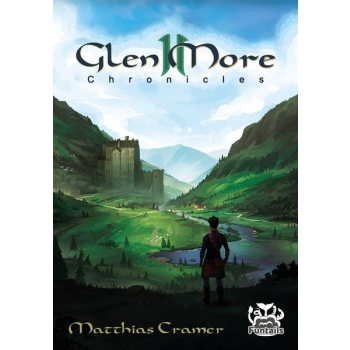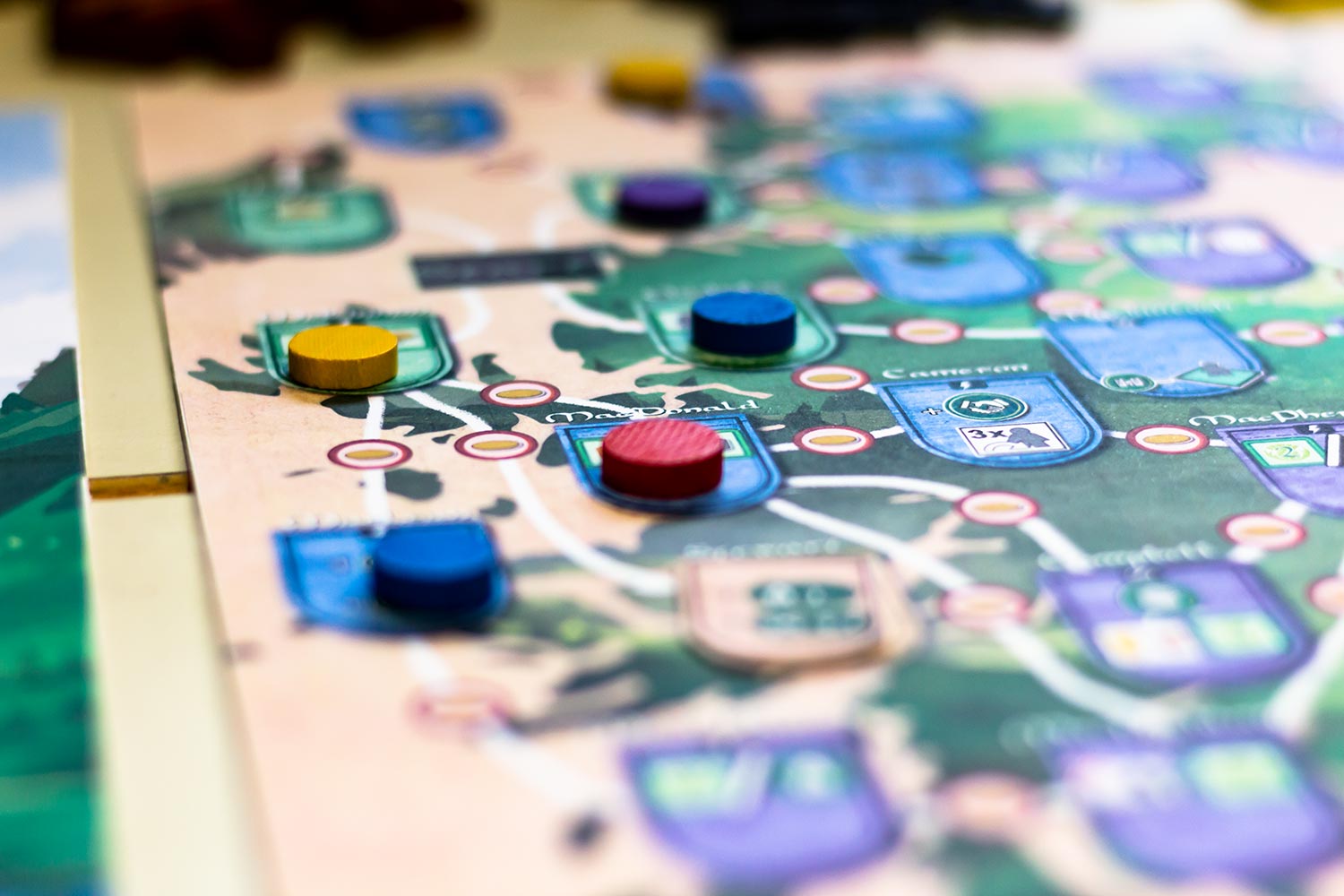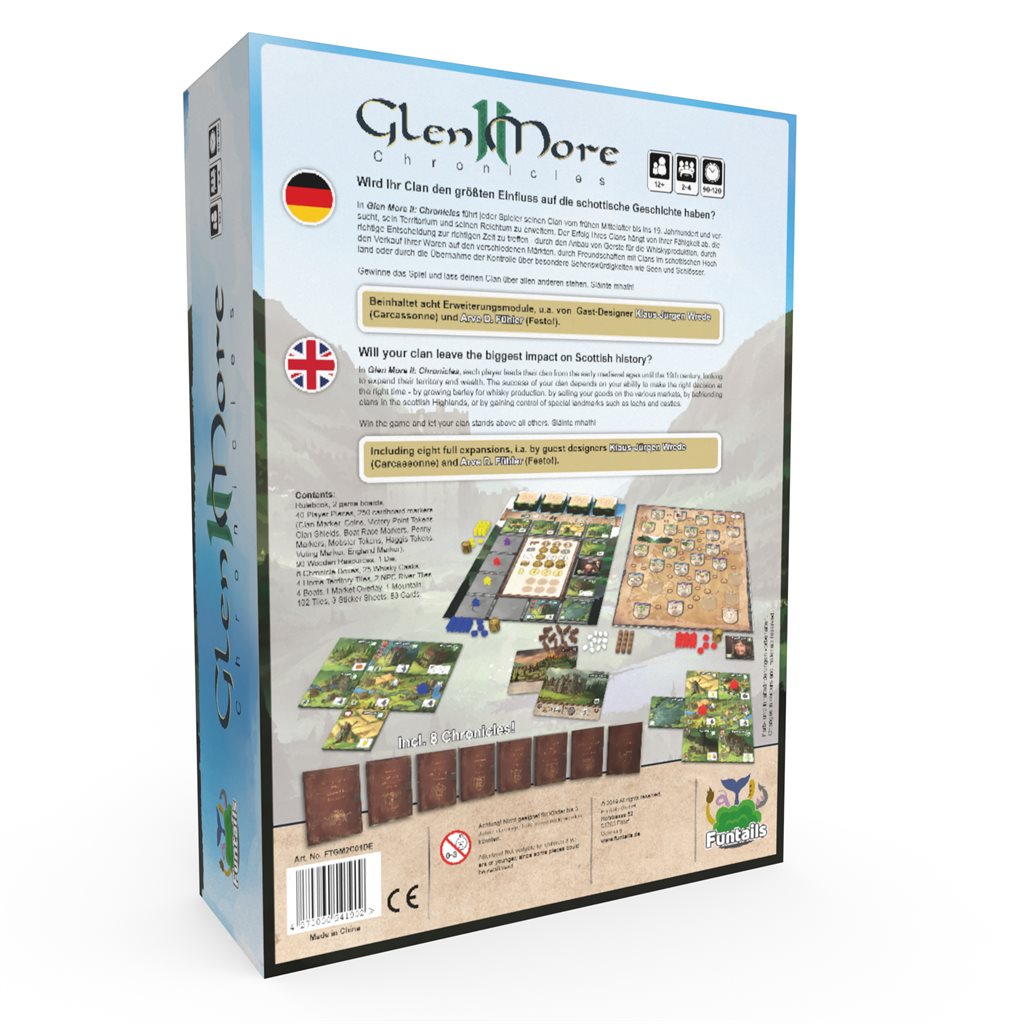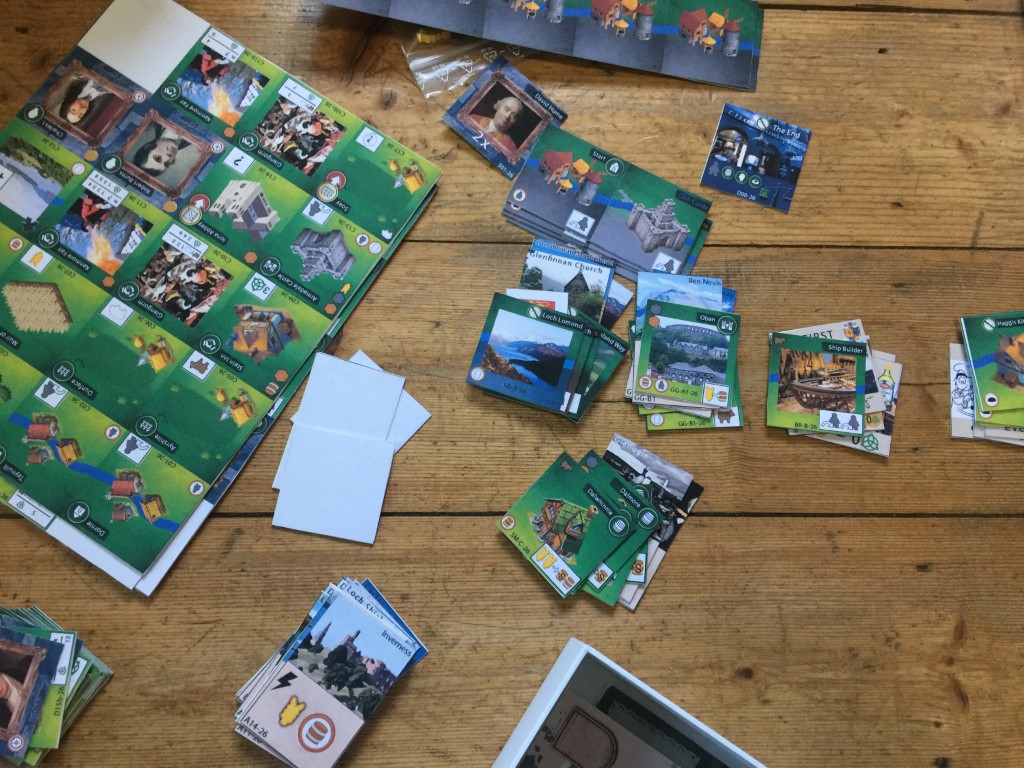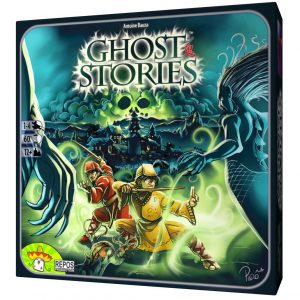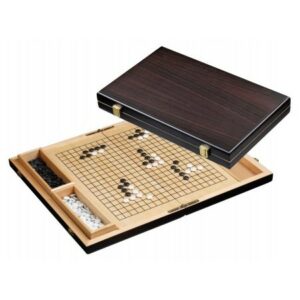Beschrijving
Min leeftijd: +12
Aantal spelers 2 a 4
Gem speelduur 90 a 120 min
In Glen More II: Chronicles vertegenwoordigt elke speler de leider van een Schotse clan van de vroege middeleeuwen tot de 19e eeuw, een leider die zijn territorium en rijkdom wil uitbreiden. Het succes van je clan hangt af van je vermogen om op het juiste moment de juiste beslissing te nemen, of dat nu is door een nieuw weiland voor je vee te creëren, gerst te verbouwen voor de productie van whisky, je goederen op de verschillende markten te verkopen of de controle over speciale oriëntatiepunten te verwerven. zoals meren en kastelen.
Het spel duurt vier rondes, vertegenwoordigd door vier stapels tegels. Na elke ronde vindt er een scorefase plaats waarin spelers hun aantal whiskyvaten, Schotten in het thuiskasteel, oriëntatiepuntenkaarten en personen vergelijken met de speler met de minste items in elke categorie en overwinningspunten (OP’s) ontvangen op basis van de relatief verschil. Na vier rondes worden extra OP’s toegekend voor gouden munten en enkele oriëntatiepunten, terwijl OP-strafpunten worden beoordeeld op basis van de territoriumgrootte, waarbij het territorium van elke speler wordt vergeleken met het kleinste in het spel.
Het kernmechanisme van Glen More II: Chronicles en Glen More werkt op dezelfde manier: de laatste speler in de rij pakt een tegel van een tijdspoor en gaat zo ver als hij wil op dit spoor. Nadat ze de kosten hebben betaald, plaatsen ze deze tegel in hun territorium, waarbij deze tegel zichzelf en alle aangrenzende tegels activeert, waardoor de productie van grondstoffen, bewegingspunten, OP’s, enz. wordt geactiveerd. Vervolgens is de speler die als laatste in de rij staat aan de beurt.
Verbeteringen ten opzichte van de originele Glen More omvatten grotere tegels, betere materialen, nieuw artwork, de mogelijkheid voor elke speler om het einde van het spel te bepalen en evenwichtige aanpassingen aan de tegels voor een betere spanningscurve. Het spel is ontworpen om voor een derde uit bekende systemen te bestaan, voor een derde uit nieuwe mechanismen en voor een derde uit verbeteringen aan Glen More.
De ‘Chronicles’ in de titel – een set van acht uitbreidingen op het basisspel – vormen een belangrijk onderdeel van deze nieuwe mechanismen. Elke Chronicle voegt een nieuw gameplay-element toe aan het basisspel. De “Highland Boat Race” Chronicle vertelt bijvoorbeeld het verhaal van een bootrace waarin de winnaar als eerste zijn thuiskasteel moet bereiken nadat hij met zijn boot langs de rivier door de territoria van alle andere spelers heeft genavigeerd. De “Hammer of the Scots” Chronicle voegt een neutraal “Engelsman”-speelstuk toe aan het tijdspoor dat spelers moeilijk kunnen beheersen om een extra beurt te krijgen – als ze het zich kunnen veroorloven, dat wil zeggen, omdat hij wordt betaald via het marktmechanisme. Alle Chronicles kunnen vrij worden gecombineerd, hoewel ontwerper Matthias Cramer suggereert dat spelers er slechts één of twee gebruiken, tenzij ze een “monsterspel” willen.
Een andere grote verandering in het spel is de mogelijkheid om te investeren in beroemde Schotse mensen uit die tijd, die worden vertegenwoordigd door een nieuw ‘persoon’-tegeltype. Personen hebben niet alleen hun eigen score, ze veroorzaken ook eenmalige of voortdurende effecten op het tactische clanbord. Dit voegt een nieuwe laag van besluitvorming toe, vooral omdat de voortdurende effecten spelers in staat stellen zich te concentreren op een persoonlijke strategie om te winnen door het gebruik van het clanbord.
In Glen More II: Chronicles, each player represents the leader of a Scottish clan from the early medieval ages until the 19th century, a leader looking to expand their territory and wealth. The success of your clan depends on your ability to make the right decision at the right time, be it by creating a new pasture for your livestock, growing barley for whisky production, selling your goods on the various markets, or gaining control of special landmarks such as lochs and castles.
The game lasts four rounds, represented by four stacks of tiles. After each round, a scoring phase takes place in which players compare their number of whisky casks, scotsmen in the home castle, landmark cards, and persons against the player with the fewest items in each category and receives victory points (VPs) based on the relative difference. After four rounds, additional VPs are awarded for gold coins and some landmarks while VP penalties are assessed based on territory size, comparing each player’s territory to the smallest one in play.
The core mechanism of Glen More II: Chronicles and Glen More functions the same way: The last player in line takes a tile from a time track, advancing as far as they wish on this track. After paying the cost, they place this tile in their territory, with this tile activating itself and all neighboring tiles, triggering the production of resources, movement points, VPs, etc. Then the player who is last in line takes their turn.
Improvements over the original Glen More include bigger tiles, better materials, new artwork, the ability for each player to control the end of the game, and balancing adjustments to the tiles for a better suspense curve. The game is designed to consist of one-third known systems, one-third new mechanisms, and one-third improvements to Glen More.
The “Chronicles” in the title — a set of eight expansions to the base game — are a major part of these new mechanisms. Each Chronicle adds a new gameplay element to the base game. The “Highland Boat Race” Chronicle, for example, tells the story of a boat race in which the winner needs to be the first to reach their home castle after navigating their boat along the river through all the other players’ territories. The “Hammer of the Scots” Chronicle adds a neutral “Englishman” playing piece to the time track that players struggle to control to get an additional turn — if they can afford him, that is, as he is paid using the market mechanism. All Chronicles can be freely combined, although designer Matthias Cramer suggests that players use only one or two unless they want a “monster game”.
Another major change to the game is the ability to invest in famous Scottish people of the time, who are represented through a new “person” tile type. Persons not only have their own scoring, they also trigger one-time or ongoing effects on the tactical clan board. This adds a new layer of decision making, especially since the ongoing effects allow players to focus on a personal strategy of winning through the use of the clan board.

